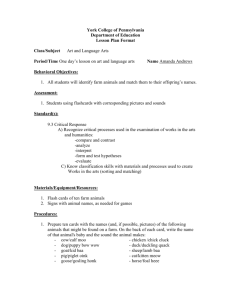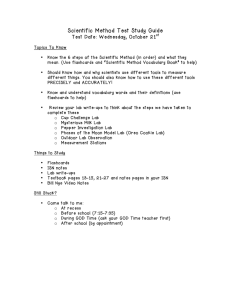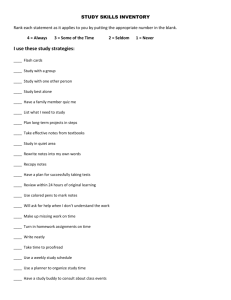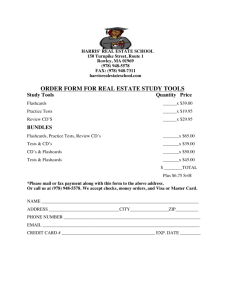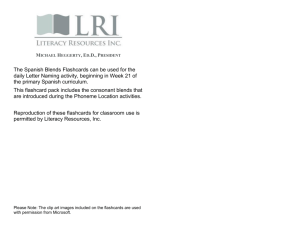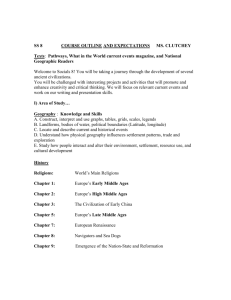Using flash cards with young learners
advertisement
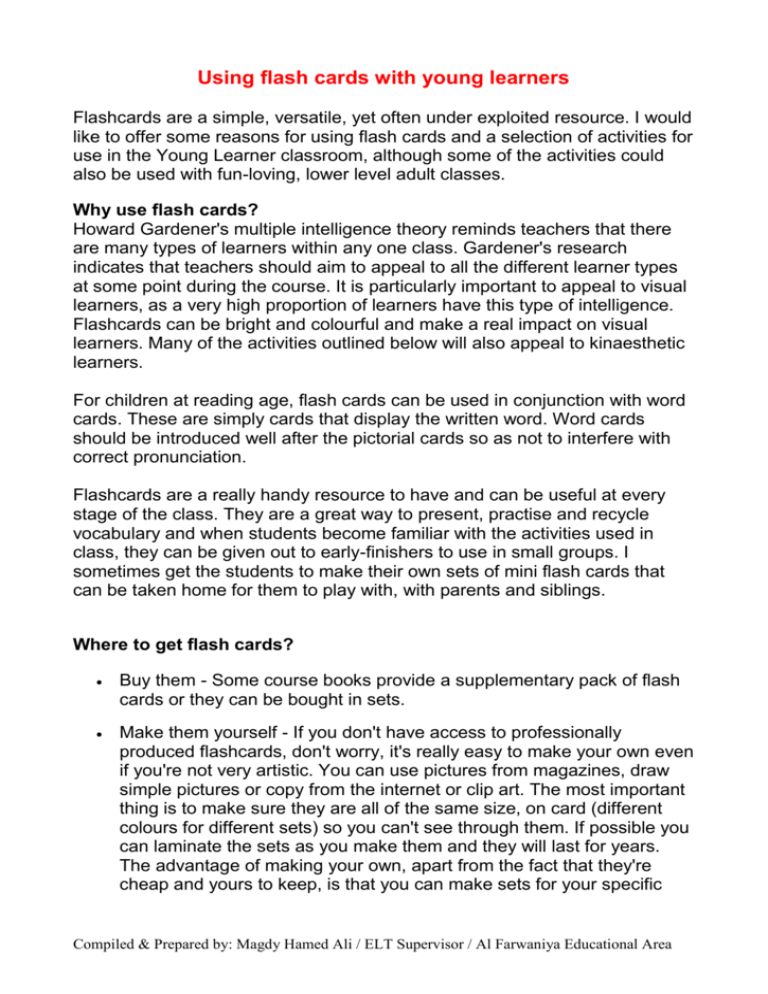
Using flash cards with young learners Flashcards are a simple, versatile, yet often under exploited resource. I would like to offer some reasons for using flash cards and a selection of activities for use in the Young Learner classroom, although some of the activities could also be used with fun-loving, lower level adult classes. Why use flash cards? Howard Gardener's multiple intelligence theory reminds teachers that there are many types of learners within any one class. Gardener's research indicates that teachers should aim to appeal to all the different learner types at some point during the course. It is particularly important to appeal to visual learners, as a very high proportion of learners have this type of intelligence. Flashcards can be bright and colourful and make a real impact on visual learners. Many of the activities outlined below will also appeal to kinaesthetic learners. For children at reading age, flash cards can be used in conjunction with word cards. These are simply cards that display the written word. Word cards should be introduced well after the pictorial cards so as not to interfere with correct pronunciation. Flashcards are a really handy resource to have and can be useful at every stage of the class. They are a great way to present, practise and recycle vocabulary and when students become familiar with the activities used in class, they can be given out to early-finishers to use in small groups. I sometimes get the students to make their own sets of mini flash cards that can be taken home for them to play with, with parents and siblings. Where to get flash cards? Buy them - Some course books provide a supplementary pack of flash cards or they can be bought in sets. Make them yourself - If you don't have access to professionally produced flashcards, don't worry, it's really easy to make your own even if you're not very artistic. You can use pictures from magazines, draw simple pictures or copy from the internet or clip art. The most important thing is to make sure they are all of the same size, on card (different colours for different sets) so you can't see through them. If possible you can laminate the sets as you make them and they will last for years. The advantage of making your own, apart from the fact that they're cheap and yours to keep, is that you can make sets for your specific Compiled & Prepared by: Magdy Hamed Ali / ELT Supervisor / Al Farwaniya Educational Area needs. You may like to make a set to use in conjunction with a story book or graded reader, or even to accompany project work. Students make them - I have recently begun to incorporate the production of flash cards into the classroom. After introducing a new lexical set, using realia or the course book, ask students to produce the flash cards for you. Give each one an item to draw. They can be mounted on card to make the set. Activities for using flash cards I have divided the activities into the following categories: Memory, drilling, identification and TPR activities. Memory Activities o Memory Tester Place a selection of flash cards on the floor in a circle. Students have one minute to memorize the cards. In groups, they have two minutes to write as many of the names as they can remember. Drilling Activities o Invisible Flashcards Stick 9 flash cards on the board and draw a grid around them. Use a pen or a pointer to drill the 9 words. Always point to the flash card you are drilling. Gradually remove the flash cards but continue to drill and point to the grid where the flash card was. When the first card is removed and you point to the blank space, nod your head to encourage children to say the word of the removed flash card. Students should remember and continue as if the flash cards were still there. They seem to be amazed that they can remember the pictures. Depending on the age group I then put the flash cards back in the right place on the grid, asking the children where they go, or I ask students to come up and write the word in the correct place on the grid. This activity highlights the impact of visual aids. It really proves that the images 'stick' in students' minds. Identification Activities o Reveal the word Cover the flash card or word card with a piece of card and slowly reveal it. Compiled & Prepared by: Magdy Hamed Ali / ELT Supervisor / Al Farwaniya Educational Area Students guess which one it is. Once the card is shown, chorally drill the word with the group using different intonation and silly voices to keep it fun. Vary the volume too, whisper and shout the words. Children will automatically copy your voice. Alternatively, flip the card over very quickly so the children just get a quick glimpse. Repeat until they have guessed the word. TPR activities o Point or race to the flash cards Stick flash cards around the class. Say one of them and students point or race to it. Students can then give the instructions to classmates. You can extend this by saying "hop to the cat" or even "if you have blonde hair, swim to the fish" etc. You can also incorporate flash cards into a game of Simon Says. "Simon says, jump to the T-shirt" etc. Joanna Budden, British Council, Spain Compiled & Prepared by: Magdy Hamed Ali / ELT Supervisor / Al Farwaniya Educational Area Flashcards in Primary Stage Flashcards are a valuable resource for teachers and parents. They are used as a linguistic or visual stimulus for learners to read, speak or write. A flashcard is a piece of card about A4 size or playing card size, depending on whether it is for class use or group work. On this card there is either a picture of a single object or scene, or a single word or phrase. Flashcards are useful because the teacher and children can pick them up, move them and display them in different places and different sequences. Picture Flashcards Picture flashcards are used for teaching and practising basic vocabulary through games. They could be pictures of animals, household objects, places, people, story characters or action verbs. Here are a few games for you to try with the whole class or in small groups. Where’s the Dog? Display a series of cards around the classroom and ask ‘Where’s the dog?’ The children look and respond, ‘The dog’s near the door.’ ‘The cat’s near the light switch.’ and so on. Hide and See Show the children a small collection of cards as you put them into an opaque envelope, giving or eliciting the word associated with each card. Slowly, take each card out of the envelope so that the picture is gradually revealed. The children race to guess and say the word associated with the picture. Show Me Put a collection of cards on a table and ask the children to find particular cards. For example: ‘Show me a fish.’ A child finds the relevant card, picks it up and says ‘This is a fish.’ If the cards are displayed around the classroom, this game can also be played as ‘Point to a fish.’ Describe and Guess Describe the picture on a card (teacher or student). The other children try to guess what is represented. Plurals You may have picture cards to illustrate plurals. The children find both cards and say ‘This is a frog. These are two frogs. Matching Games If you have cards illustrating places, children can match the animals with their Compiled & Prepared by: Magdy Hamed Ali / ELT Supervisor / Al Farwaniya Educational Area natural environment, for example, the frog and the pond, the fish and the sea, the spider and web. This can produce short sentences like ‘The frog is in the pond . ‘The fish is in the sea.’ and so on. Collecting and Grouping Cards Children can collect cards into sets. They might collect ‘Toys’ or ‘Food’ or ‘Animals that live in the sea’. Children can also play ‘Happy Families’ as they try to complete sets of four cards. These might be a blue pen, a red pen, a green pen and a black pen. Action Cards Action cards illustrate verbs rather than nouns. Typical action cards might be: reading, writing, drawing, speaking, eating, drinking, playing, running, riding, swimming, laughing, crying, and so on. These action cards can be combined with picture cards to elicit short sentences like ‘The bird is flying in the sky.’ ‘The fish is swimming in the sea.’ and so on. Adjective Cards You may want to produce a series of picture cards to illustrate basic adjectives. Obviously we can start from colour adjective cards, but we can also illustrate happy, sad, tall, short, heavy, light, fat, thin, hungry, frightened, and so on. Word Flashcards Word flashcards have a single word or phrase written clearly on the card. They are very useful for the early ‘word recognition’ phases of reading. Nearly all of the games for picture flashcards can be played with word flashcards. Here are some more ideas of how you can use word flashcards. Using Word Cards on the Board Attaching word cards to the board can be very useful when explaining simple grammatical procedures, such as subject/verb inversion in question forming. Matching Words and Pictures Place the picture cards on a table on one side of the room and the relevant word cards on a table on the opposite side of the room. Children choose a picture card and then move and try to find the matching word card. Then they return to the picture cards to choose another, and so on. Snap! Two children have mixed sets of picture and word cards. In turn, each child puts the first card face up on the desk and says the word. The other child Compiled & Prepared by: Magdy Hamed Ali / ELT Supervisor / Al Farwaniya Educational Area responds by placing the first card in his or her pile on the table and saying the word. If the cards match each other the child does not say the word but says ‘Snap!’ and picks up all the cards that have been played. The game ends when one child has all the cards. Find the Pair Lay a set of picture and word cards face down on a table. Children turn over two cards in each turn. If they find a pair, they take the cards. If they do not find a pair, they turn the cards face down leaving them in the same position. This game not only has linguistic benefits, it is very good for children’s awareness of spatial relationships. Making Sentences Many blackboards or whiteboards have a narrow shelf for chalk or pens. These shelves are very useful for building sentences with word or picture cards. The teacher hands out a collection of cards that will make a sentence and asks the children to arrange the cards on the shelf in the correct order to make the sentence. This game helps simple reading and awareness of word order in simple sentences. Story Cards Stories that are told and retold are very important when teaching young children. Story cards illustrate key events in the story and act as prompts for the children to retell the story. Making Flashcards You can make your own flashcards or ask your children to help you! They particularly like making story cards! You can draw your own pictures or cut out pictures from magazines and paste them onto cards. Use fairly big cards, so that all children can see them clearly. They last much longer if you cover them in plastic and store them in boxes. Compiled & Prepared by: Magdy Hamed Ali / ELT Supervisor / Al Farwaniya Educational Area
